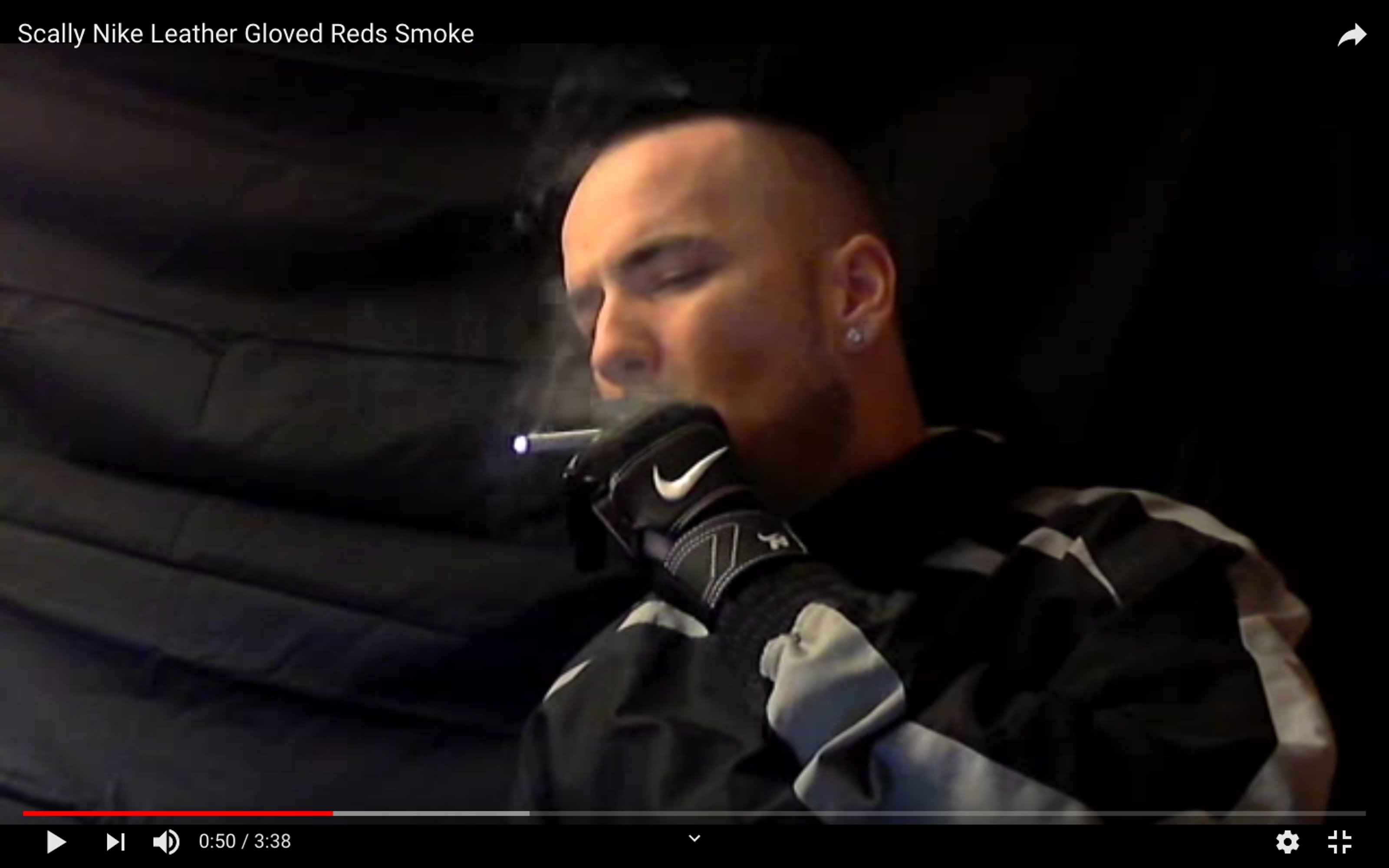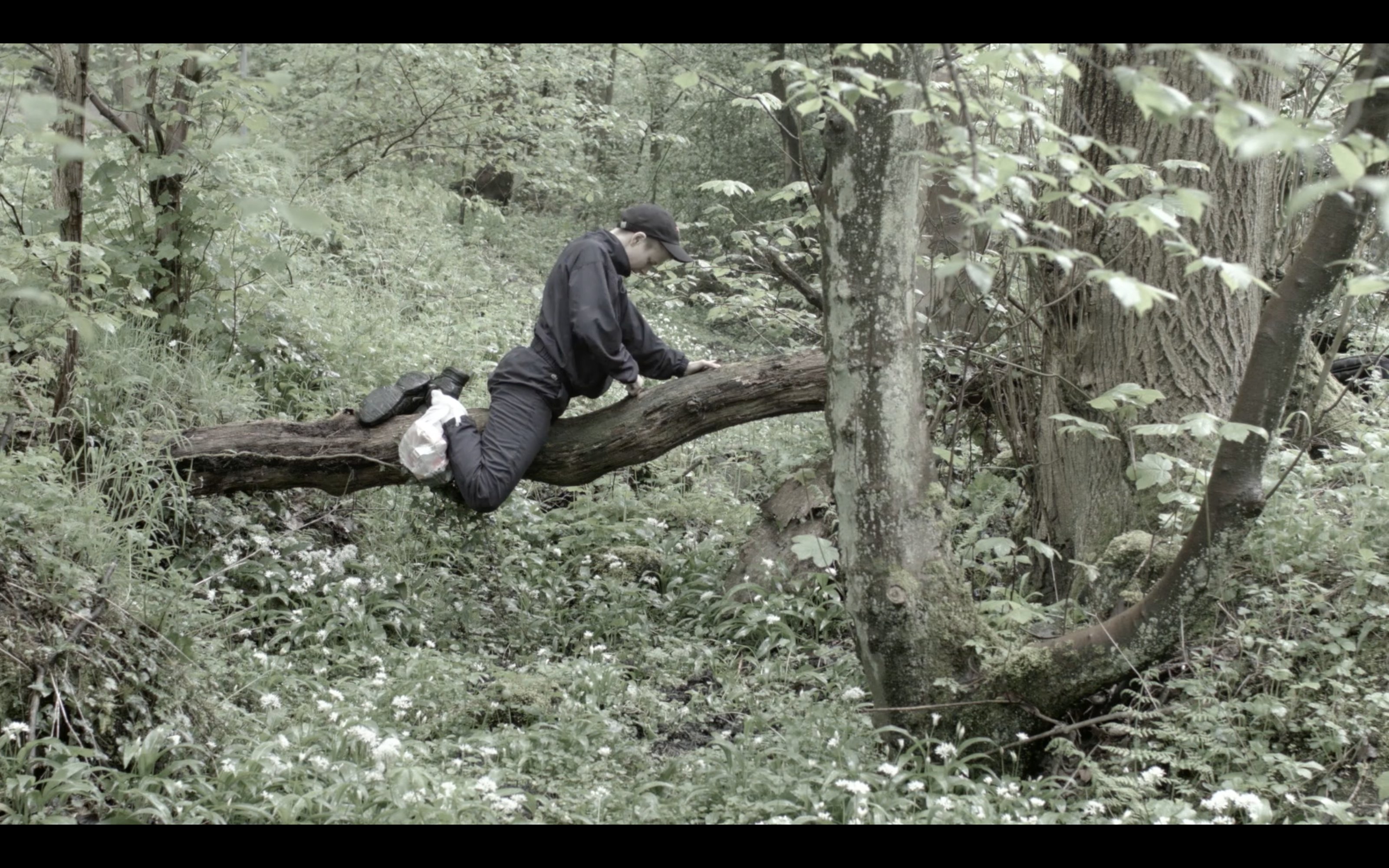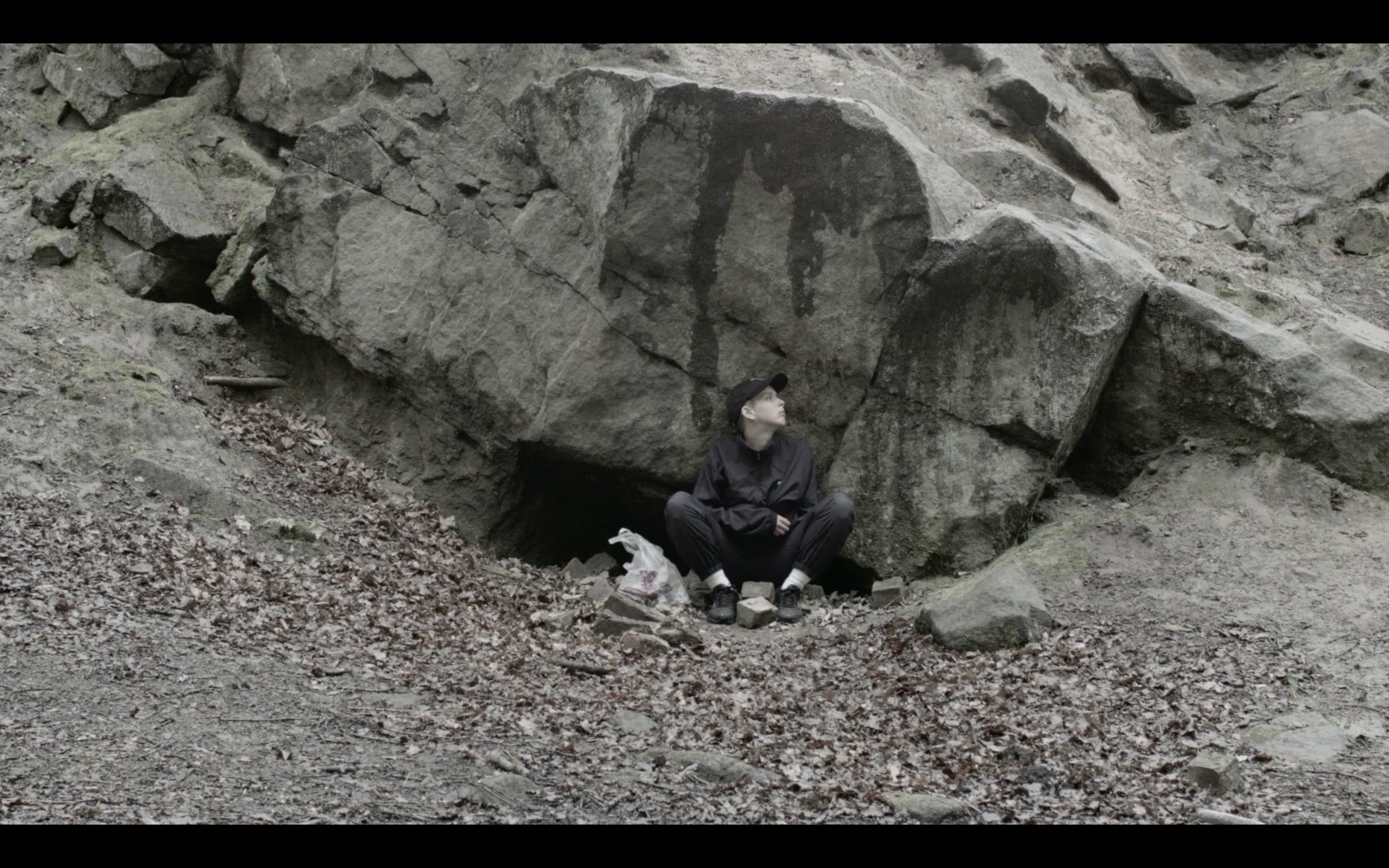Roy Claire Potter, performer, artist and writer, engages with themes of class, gender and regionalism. The political landscape of 2019 led to a rehash of long established prejudices regarding regional attitudes to art, culture and politics — that experimentalism and queerness are somehow the exclusive domain of a metropolitan elite and beyond the man on the Cumbrian omnibus. By stark contrast, Potter’s work does the business of actually re-presenting the case for an aesthetic weirdness that has always been intimately boundaried and unbounded by traditional class and regional identities. It is some of the most vibrantly political work of the time, without being reduced solely to the political, with all the raw-kneed intensity of a youthful scrap, neither turning away from or turning out the multiple contradictions it inhabits simultaneously with respect to sexuality, tenderness, violence and class.
A suitable entry point for Potter’s work is the tape Nike Scally Leather Glove Smoke (Chocolate Monk, Brighton: 2017, later reissued on CD 2018). The opening track ’CHAVSCUMBOSS’ (the text of which is published in Round the Way, Ma Bibliothéque, London: 2017), signposts a series of search terms, which strung together uncover the source material for Potter’s performance: a YouTube channel comprised of the videos of the same man engaging in minimal, performative acts, such as smoking, while dressed in leather or branded sportswear.
‘Chav’ is a pejorative term that is intended to denote a strata of working class people, frequently portrayed as projecting a self-confidence that is considered unbecoming by the middle classes. Michael Carroll, a former binman and lottery winner at 19, became branded as “King of the Chavs” by the press for his pure enjoyment of sudden, obscene wealth. In a move that would be bewildering to most US pundits, the Beckhams were described as being chavs for having the temerity to be born in Essex. It is an archaic term in 2020, having reached its height in usage around 2005. ‘Scally’, an equally loaded classist term, offers a greater sense of locatedness, most commonly associated with people from Liverpool and its surrounds. It again is associated with bravado, a projected self-confidence, that is regarded as beyond the pale. These terms for the most part seem rooted in middle class insecurity, an anxiety that the material trappings of wealth or the self-confidence of public schooling are not as fixed a boundary as they might wish. These terms remind us that for many the “poor”, the working class, or those from the post-industrial north, are only considered worthy of being unreconstructed moral ciphers, a clumsy weather vane for the political discourse of the mainstream political parties or the subject of derision.

To describe the Chavscumboss videos is to do some of Potter’s labour, albeit without the same level of care. For Potter, the steady repetition of detail becomes a meditation of close attention, fixation, the pursuit of unspoken potentiality:
watch this figure smell the hands
objects from
elsewhere
smell elsewhere.
The relaying of these micro-events, designed for largely anonymous consumption by sportswear fetishists, take on a rarer hue in the performative space of galleries, the CD-Rs of prestige noise labels and pages of boutique publishing projects. They are presented without judgement, though function primarily as a series of speculative stopping off points. Potter opens up the descriptive field through a precise invoking of elsewhere. The text begins with the folds of a bedsheet pinned behind the video’s subject, leading to an estimation of the weight of the individual, the newness of the material and the method by which it is attached to the wall. Later in the piece the same detailed scrutiny is applied to gloves, cigarette tips, smoke and inhalation. It feels tender, intimate, but also dissociative, as if the potential of the subject (both as threat and erotic object) causes the text to look anywhere but there. The tension between the subject and the space around him, his accoutrements and manner of interacting with the viewer (reader) are all pushed to the forefront of Potter’s work. This dissociative closeness is made explicit, “he is looking at the screen like a numb hand can feel like a stranger’s on your own cock can’t it?” Do we read this disassociation as the subject’s? Is it the narrator’s? Is it our ours? This questions about the right to present, the right to possess and possessed shuttles between these three points, those fixed in the text as, “performer performance and audience”.
There is a complex relationship at play in the presentation of men (it is predominantly men) in branded sportswear as fetish objects. On one hand, it is no more distinct than any other fetish, a particular object acts as a substitute in the matrix of one’s desire. However, it can, like many fetishes, play uneasy games with notions of power and control. The branded sportswear seen in these videos is associated most frequently with working-class culture. It turns on a complex axis of associations, elements that can speak to prior experience in or around these communities, a sense of othering, or plain exploitation. Potter’s work draws all this to the surface, and also throws a reflection back on its audience. The prevalence of budget, branded sportswear amongst the average small gallery art set will likely not have escaped the notice of even a casual spectator. It is not solely an indicator of the popularity, availability and comfort of the brands, but a sometimes conscious affectation, as articles in periodicals as diverse as Highsnobiety, the Evening Standard and Vice have attempted to delineate. Much of this is termed an “anti-fashion” by the above, as if the wearer has consciously transcended fashion by appropriating a series of clumsy signifiers. The presumption is that working-class identity can be reduced and replicated by a series of tribal identifiers, ones that conveniently can be taken wholesale without the need to engage in much more than a transaction in Sports Direct. Such an act, if claimed as transcendent or somehow authentic (read: ironic but with a furrowed brow), is also painfully tone-deaf to the material exploitation of working class labour, both in sweatshops and warehouses, and the cumulative environmental impact of the clothing industry. It also disregards these brands as symbolic of status, or identity, of a pride in owning a decent get-up (particularly consider the nerve required to then define that as “anti-fashion”, as if those feelings are mute). It should be clear that none of the above is raised to prohibit the wearing of tracksuits, or to deny a plurality of motivations in what we might choose to wear, but it is important to remember when considering the associations it will play with in terms the performance and context of ‘CHAVSCUMBOSS’. To paraphrase Mark Fisher in Capitalist Realism, an online industry in itself, any act of subversion undergoes a further subversion in the service of capitalism.

image: Chavscumboss, Scally Nike Leather Gloved Reds Smoke. Youtube Clip.
Potter’s presentation of this material, the dissociation that is brought to it, is a turn back on the audience itself, a thrilling act of subversion:
This man is performer performance and audience. The
image he makes will never really address him
can’t ever look into his eyes. There
are two.
When he looks into the camera a moment of address
is synthesised. He’s looking at me. There are two. The
person wears an image. The image is a man who might
yet have some power.

Roy Claire Potter – Cast Metal Nut, HD single channel film, 38mins, 2016 (Video Still)

The implicit threat of violence, a significant element of the original fetish video, is retained in the text, “The cheeks of your face and your arse would be raw if his head had touched them.”, “open pores stabbed”, “in general he squares/up/To everyone/indiscriminate”. However, it is also a violence wished upon the subject, “Get it out of him whatever is inside! Supposing an inside, supposing also a he. Even so break him open. Even if there is no him!” What are we to do with this threat to self-identity, to the performance of a self-identity signified through clothing, attitude, stance, all of which is presented for the gratification of a viewer, then doubled over and re-presented back? Judith Butler’s extensive writing on drag and acts of gender performativity might be immediate touchstones for the audience, and with good cause. Potter’s work comes to mind when reading of gender as “an identity tenuously constituted in time, instituted in an exterior space through a stylized repetition of acts” (p191), but it is also important to recognise this was already present in the original Chavbossscum videos. The subversion has not been to mould the source material to suit Butler’s critical framework, and as Butler’s Bodies That Matter makes explicit, “there is no necessary relation between drag and subversion” (p85). Potter’s subversion is to take us all one step beyond this — to ask what it means for us as an audience or reader to re-read it in those terms, and to consider our own relationship to it, our own assumptions and our desires in the context of the material. The Chavscumboss YouTube channel has just under 5,000 subscribers, raising critical questions about the perception of cultural dominance, and the presumptions made about the exclusivity of the ideas, their cultural cache as obscure objects of desire.
Image: Chavscumboss, Adidas Chile Marlboro Reds Smoke. Youtube Clip.

The low key manner of the videos is reminiscent of the aesthetics of eighties counter-cultural journal Rapid Eye, a skirting on the boundaries of queer and esoteric tastes. There is also a further resonance there, Rapid Eye arrived at a time of moral panic about ‘video nasties’, and its material centred on a chauvinistic attitude of “boundary pushing”. A feature on phone booth cards was largely an excuse to reproduce pornographic material. Genesis P. Orrdige popped up more times than is healthy for any magazine. Video, both in production and grubby fingered distribution networks, provoked a series of questions about censorship. In a similar way, the internet, and particularly user driven platforms like YouTube, see the taboo being redefined and old kinks rewired. One need only review the amount of readily available amateur pornographic content, both straight and LGBTQA+ orientated, to realise that it is dynamically reliant on self-production, scratch aesthetics and quick fixes. The economic and aesthetic innovations of an industry collapsing, as explored in Paul Thomas Anderson’s Boogie Nights and Jon Ronson’s The Butterfly Effect, contribute to an undertow here. This notion of old orders shifting, and new ones becoming viable, is prevalent, and there is an overriding sense that every new element could cause things to spin into either total subjugation and total freedom, or both simultaneously. Return briefly here to the sportswear fetishists, the hip artists and the gallery space. What occurs within Potter’s writing, the balance between close attention and disassociation, tenderness and threat, lays intentionally at the root of this ambiguity. Here is desire, in all its toxicity, all its fluidity, its fraught dynamics. Here it is, with its utopianism, its shrugging off of old identities and putting on of new ones. Potter’s work is a receptivity to complex pluralities, without turning away from the tensions and contradictions that inhabit them. It is both work located and unlocatable in its exploration of class, bodies, queerness and politics, and the critical demands it makes of its audience and readership is an essential accompaniment for these weird end times.
image: Roy Claire Potter – Cast Metal Nut, HD single channel film, 38mins, 2016 (Video Still)